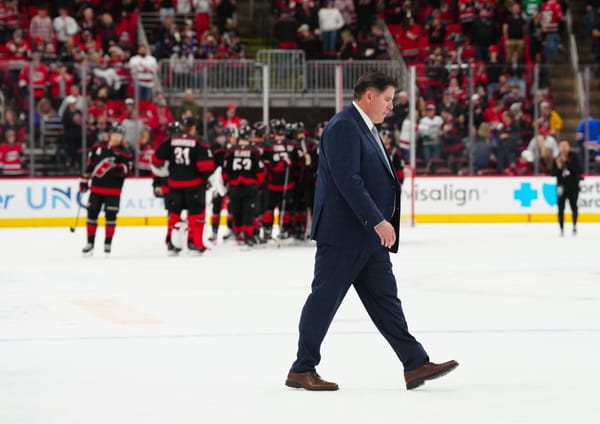Reflecting on Mike Richter’s place in Team USA History
Not just a Rangers great, Richter also holds a special place in Team USA’s history
For those of you who grew up watching Kurt Russel crossing his arms in plaid suits in the movie Miracle, it may be surprising to hear that Team USA struggled after defeating the Soviet Union and Finland 1980. In fact, the U.S. would not see another medal in men’s hockey in the IIHF World Championships or the Olympics until 2002 in Salt Lake City.
For most New York Rangers fans, Mike Richter is immortalized because of the role he played on the 1994 Cup team. Fans think of the save on Pavel Bure; they think of John Davidson boasting about beautiful glove saves; they think about an exceptional NHL career that was limited and ultimately cut short by injuries.
The 5-foot-11 netminder is also one of just 10 players of Team USA’s men’s national team to appear in three Olympics — even more impressively, he represented his home country in Olympic tournaments in three different decades.
Richter holds a unique place in Team USA’s history. He helped the national team program begin its climb back up the mountain after it crashed following the rapture that followed the Miracle on Ice.
Early Appearances (1980s)
Richter made his debut on the senior national team at the 1986 IIHF World Championship at the age of 19. Just four months beforehand, he had backstopped USA’s U-20 team to a bronze medal finish. Richter’s only appearance in the men’s tournament at the 1986 Worlds was a rocky one — he allowed five goals in 53 minutes of play. The U.S. went 2-5-0 in the group stage that year, managing to beat only Poland and West Germany; they were outscored 23-11 in their five defeats.
The following year, at the 1987 Worlds, Richter allowed eight goals in 80 minutes of hockey. He finished that tournament with an .884 save percentage, which is more impressive than it might seem at first blush. Team USA was defeated 11-2 by the Soviet Union that year and finished the tournament with a minus-17 goal differential in all situations. In other words, USA Hockey was a far cry from the program that it is today.
Needless to say, Richter’s save percentage through those first two tournaments looked pretty rough. But, as is always the case when it comes to stats, context is everything.
Chris Terreri, who enjoyed a long NHL career with the New Jersey Devils, Chicago Blackhawks, San Jose Sharks, and the New York Islanders, split the starting goaltending role with Tom Barrasso at the 1986 Worlds. Terreri managed an .895 save percentage through 286 minutes of play; Barrasso put up an .887 save percentage through 260 minutes of hockey.
John Vanbiesbrouck replaced Barrasso at the 1987 Worlds and took on the biggest workload of Team USA’s netminders. He finished that tournament with an .850 save percentage and a 4.10 GAA. Terreri, who played 20 more minutes than Richter at the 52nd IIHF World Championship, finished with a .727 save percentage and a 7.20 GAA. Although Richter played just 80 minutes, his .884 save percentage definitely stands out — especially for a 20-year-old.
At the 1988 Olympics in Calgary, Team USA had the youngest team by an average of two years. A 19-year-old Brian Leetch turned a lot of heads in Calgary by putting up six points in six games and Corey Millen, the Rangers’ 57th overall pick of the 1982 NHL Draft, led the team in scoring with 11 points. The play of a then 21-year-old Richter was also a silver lining.
Richter stopped .842 percent of the shots he faced through 230 minutes of hockey at the 1988 Winter Games. Terreri was the only other U.S. goaltender who stood in the blue paint for the U.S.; he posted a .738 save percentage in 128 minutes. One could definitely make a case that Terreri had a harder schedule because he faced the Soviets. But Richter played West Germany and Czechoslovakia — the teams that finished second and third in the group, respectively — and earned Team USA’s only two wins in group play.
Entering his Prime (1990s)
By the time Richter played for Team USA at the 1991 Canada Cup, he had nearly 70 games of NHL experience under his belt. In that tournament, he was in net for all four of the team’s victories and finished with a .904 save percentage. Thanks in large part to Richter’s play, the U.S. finished second to Canada.
Two years later, Richter posted a .903 save percentage and a 3.29 GAA in 237 minutes of hockey at the 1993 Worlds. Although USA finished in sixth, it was becoming abundantly clear that they had something special in Richter. Any reservations about the undersized goalie from Abington, PA quickly expired a little over a year later when he finished the 1994 NHL Playoffs with a .921 save percentage and a Stanley Cup.
Richter returned to duty with the national team at the inaugural World Cup in 1996 and straight up stole the show. He earned honors as the tournament’s MVP and helped USA capture gold. Richter finished the World Cup with a 5-1-0 record, a .923 save percentage, and 2.43 GAA. To add some context to that performance, Curtis Joseph played in seven games for Team Canada and finished the tournament with a .908 save percentage playing behind a blue line that featured Scott Stevens, Scott Niedermayer, Rob Blake, and Paul Coffey.
Want to see that again? Of course you do. Here’s another angle.
Naturally, expectations were high for him and the rest of Team USA two years later at the Nagano Olympics. Unfortunately, the Americans failed to gain much traction in the group stage as a result of sharing Group D with both Sweden and Canada. Richter and his teammates fell to the Czech Republic by a score of 4-1 in the quarterfinals. He finished the tournament with an .850 save percentage and a 3.54 GAA.
Sweet Silver (2002)
At the age of 35, after having reconstructive surgery on both of his knees and enduring concussions, Richter returned to play for Team USA one last time at the Salt Lake City Olympics. With the world watching, he found a way to defy the odds and turn back the clock.
Richter was even better at Salt Lake City than he was at the 1996 World Cup. For four games, Richter put his team on his back. He stopped 33 of the 35 shots he faced against Russia in the group stage, earning Team USA a tie despite the fact they were out-shot by 10 shots. Richter followed that performance with a 28-save shutout against Germany in the quarterfinals.
In the semifinals Richter returned to the crease to face Russia. The difference this time around was that Team USA’s offense decided to show up. Richter stopped 28 of the 30 shots he faced to punch his country’s ticket to the gold medal game against Canada. Unfortunately, the U.S. was unable to capture its first gold since 1980. Richter allowed five goals on 39 shots — four of which came from the sticks of Jarome Iginla and Joe Sakic. The skaters in front of him beat Martin Brodeur twice in the 33 shots they got through Canada’s stacked blue line.
At the conclusion of the Salt Lake City Olympics, Richter had a silver medal around his neck and a .932 save percentage. He was named a media All-Star for his classic performance, but Nikolai Khabibulin earned the nod as the Best Goaltender of the tournament. However, the American netminder’s save percentage was the best in the tournament among goaltenders who played at least 180 minutes by a wide margin.
Just 13 games into the 2002-03 season, Richter’s NHL career ended after taking a slap shot to the mask. The impact fractured his skull and gave him a concussion. He announced his retirement from professional hockey in 2003.
Legacy
Among American-born NHL goaltenders, Richter ranks fourth in all-time games played (666) and fifth in wins (301). His .904 career save percentage — which was dragged down as a result of the injuries he endured and the poor play of the Rangers in his final three seasons — ranks 13th among U.S. goaltenders who have played in at least 200 games.
On Oct. 10, 2008, Richter was inducted into the U.S. Hockey Hall of Fame. Less than a year later, on Sept. 18, 2009, Richter received the Lester Patrick Trophy for his contributions to hockey in the United States. In 2014, he was inducted into the Philadelphia Sports Hall of Fame. Furthermore, the Mike Richter Award is given annually to be NCAA goaltender deemed to have had the best season.
Whether or not Richter is the greatest American-born goaltender will be up for debate for decades to come. With that being said, you’d be hard-pressed to find anyone who would rank the Rangers legend outside of the Top-3 best U.S. goalies. After hoisting Lord Stanley’s Cup, Richter upset Team Canada and shocked the world at the 1996 World Cup and carried Team USA to its first Olympic medal in men’s hockey in over 20 years at Salt Lake City. There is no doubt as to who the team’s most valuable player was in those events.
The U.S. men’s national team earned another silver at the 2010 Olympics in Vancouver, but has failed to reach new heights at the Worlds or Olympics since Richter’s retirement. Make no mistake, there have been great American goalies since #35 hung up his skates, but none have been able to repeat what Richter did not once, but twice, with the world watching.
Data courtesy of USAHockey.com, quanthockey.com, EliteProspects.com, IIHF.com.




